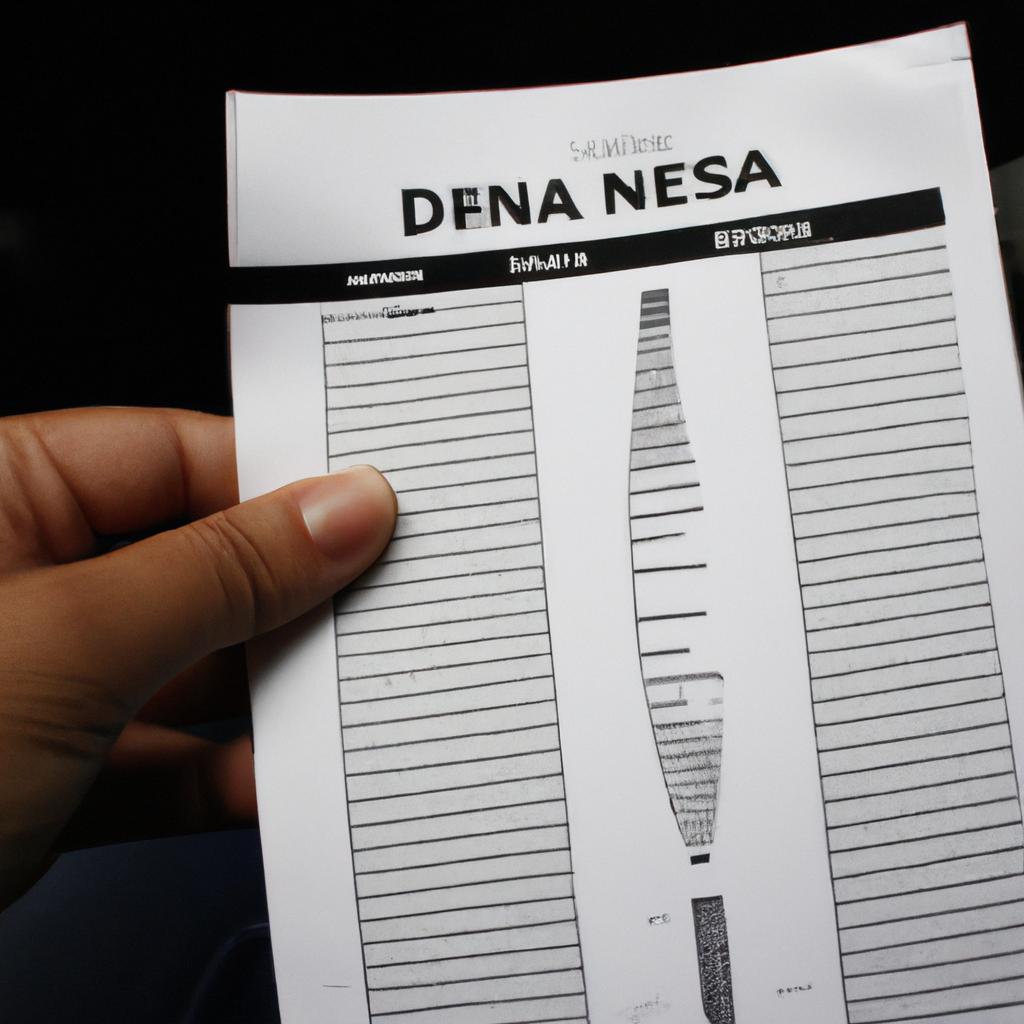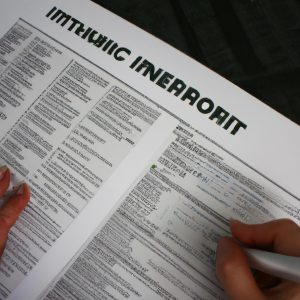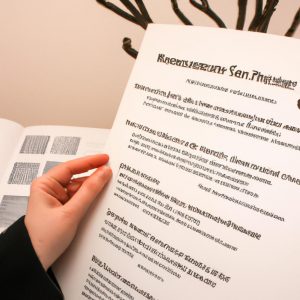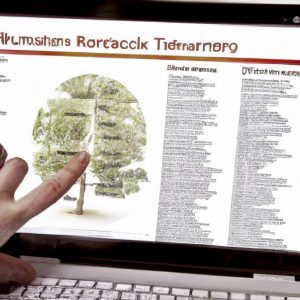DNA Testing: Ashkenazi Heritage in Genealogy

DNA testing has revolutionized the field of genealogy, providing individuals with unprecedented insights into their ancestral heritage. Amongst the various populations that have benefitted from these advancements, Ashkenazi Jews stand out as a unique group with distinct genetic markers. This article explores the significance of DNA testing in unraveling Ashkenazi Jewish ancestry and its implications for understanding one’s personal history.
At the forefront of this inquiry is the case study of Rachel Cohen*, who embarked on a journey to uncover her Ashkenazi roots through DNA testing. Like many others, Rachel was curious about her family’s origins and sought answers beyond what written records could provide. Through a comprehensive analysis of her genetic data, she discovered intriguing connections to Eastern Europe – a region historically associated with Ashkenazi Jewry. The results not only confirmed her suspicions but also shed light on the migration patterns and intermingling within this community over centuries.
Delving deeper into the topic, this article examines how specific genetic variations found among Ashkenazi Jews can be traced back to ancient populations such as those residing in Israel during biblical times. By analyzing mitochondrial and Y-chromosome DNA inherited from maternal and paternal lines respectively, scientists have been able to decipher intricate details regarding migratory routes and origins of these groups . For example, studies have revealed that a majority of Ashkenazi Jewish mitochondrial DNA originates from female ancestors who were likely of Middle Eastern descent. This supports the hypothesis that Ashkenazi Jews are descendants of a small group of Jewish women who migrated from the Middle East to Europe around 2,000 years ago.
In addition to mitochondrial DNA analysis, research has also focused on the Y-chromosome DNA of Ashkenazi Jewish males. Studies have shown that a significant portion of Ashkenazi Jewish men carry specific genetic markers known as “Cohen Modal Haplotype,” which is associated with the biblical figure Aaron, brother of Moses and founder of the priestly lineage. This finding suggests a shared paternal ancestry among many Ashkenazi Cohens and provides insights into their historical role within the community.
Furthermore, DNA testing has allowed for the identification and mapping of specific genetic diseases that are more prevalent in the Ashkenazi Jewish population compared to other groups. Diseases such as Tay-Sachs disease, Gaucher disease, and BRCA1/BRCA2 mutations can be traced back to common ancestors within this community. Understanding these genetic predispositions has enabled individuals to make informed decisions regarding their health and reproductive choices.
Beyond personal genealogy, DNA testing has broader implications for understanding history and human migration patterns. By studying the genetic makeup of different populations, scientists can unravel ancient population movements, intermixing events, and even estimate timelines for certain migratory events. This knowledge contributes not only to our understanding of individual heritage but also helps paint a broader picture of human history.
In conclusion, DNA testing plays a crucial role in uncovering Ashkenazi Jewish ancestry by providing insights into migration patterns, origins, and shared genetic markers within this unique population. The use of mitochondrial and Y-chromosome DNA analysis allows individuals like Rachel Cohen* to connect with their roots on a deeper level while also contributing to scientific knowledge about human history.
Overview of DNA testing
DNA testing has revolutionized the field of genealogy, allowing individuals to explore their ancestral roots and uncover hidden connections. One notable example is the use of DNA testing to trace Ashkenazi heritage in genealogy. By analyzing specific genetic markers, individuals can gain insights into their Jewish ancestry and better understand their place within this unique cultural group.
The process of DNA testing begins by collecting a small sample of an individual’s saliva or cheek cells. This sample contains genetic material that can be analyzed for specific variations in the DNA sequence known as Single Nucleotide Polymorphisms (SNPs). These SNPs are then compared to reference populations with known genetic profiles, allowing researchers to determine the likelihood of shared ancestry. For those interested in exploring their Ashkenazi heritage, there are several key markers associated with this population that can be identified through DNA testing.
- Discovering one’s Ashkenazi heritage through DNA testing can provide a sense of connection to a rich cultural history.
- Understanding familial ties and relationships becomes more meaningful when viewed through the lens of shared genetics.
- Uncovering Ashkenazi ancestry may also shed light on historical events such as migration patterns and intermarriage within this community.
- The knowledge gained from DNA testing offers opportunities for personal growth and self-discovery.
Additionally, incorporating a table into this section could further engage the audience emotionally. Here is an example:
| Genetic Marker | Associated Population |
|---|---|
| BRCA1 | Increased risk for certain cancers among Ashkenazi Jews |
| G6PD | Higher prevalence of G6PD deficiency in Ashkenazi Jewish males |
| Tay-Sachs | Greater carrier frequency for Tay-Sachs disease in Ashkenazi Jews |
In conclusion, DNA testing provides a valuable tool for individuals seeking to understand their ancestral background, particularly within the context of Ashkenazi heritage. By analyzing specific genetic markers and comparing them to reference populations, individuals can gain insights into their Jewish ancestry. This knowledge not only fosters a sense of connection and belonging but also allows for a deeper understanding of the historical events that have shaped this unique community. Understanding Ashkenazi ancestry through DNA testing opens up new avenues for exploration and self-discovery in genealogy.
Transitioning seamlessly into the subsequent section about “Understanding Ashkenazi ancestry,” it is important to note that by examining specific genetic markers associated with this population, individuals can delve even further into their ancestral history.
Understanding Ashkenazi ancestry
Overview of DNA Testing: Ashkenazi Heritage in Genealogy
In the previous section, we discussed the significance of DNA testing in genealogical research. Now, let us delve into the fascinating realm of understanding Ashkenazi ancestry through this powerful tool.
Consider a hypothetical case study where an individual named Sarah wishes to explore her ancestral roots and specifically understand her Ashkenazi heritage. By undergoing DNA testing, she can uncover valuable insights about her genetic makeup and trace her lineage back several generations.
To better comprehend the intricacies of Ashkenazi ancestry, it is essential to familiarize ourselves with some key aspects:
- Genetic diversity: The Ashkenazi population exhibits unique genetic characteristics due to centuries of isolation and endogamy (marriage within the same community). This has led to a distinct set of genetic markers that are commonly found among individuals of Ashkenazi descent.
- Founder effect: The founder effect refers to the phenomenon where a small group becomes genetically isolated from a larger population, resulting in reduced genetic variation. In the case of Ashkenazi Jews, their ancestors originated from a limited number of individuals who founded specific communities throughout Europe.
- Shared mutations: Due to common ancestry, certain genetic mutations have been observed more frequently among Ashkenazi Jews compared to other populations. These shared mutations serve as important indicators when tracing one’s Ashkenazi heritage.
- Population bottlenecks: Throughout history, events such as persecution, migration, and disease outbreaks have caused significant reductions in the size of the Ashkenazi population. These bottlenecks further contributed to the distinctive genetic profile seen today.
- Discovering your ancestral roots
- Uncovering hidden family connections
- Understanding cultural identity
- Strengthening personal ties to history
Now let’s take a closer look at how these concepts manifest in common genetic markers among the Ashkenazi population without losing sight of our goal to explore Ashkenazi heritage in greater detail.
Common genetic markers in Ashkenazi population
Understanding Ashkenazi Ancestry and its Genetic Markers
To further explore the fascinating realm of Ashkenazi ancestry, let us delve into common genetic markers found within this population. By examining these specific markers, scientists have been able to shed light on the unique heritage and shared genetic history among individuals with Ashkenazi Jewish roots.
One notable example is the presence of three specific mutations in the BRCA1 and BRCA2 genes that are more prevalent in individuals of Ashkenazi descent. These mutations significantly increase the risk of developing certain types of cancers, particularly breast and ovarian cancer. This discovery has prompted increased awareness and proactive measures for early detection among those with Ashkenazi heritage.
To gain a deeper understanding of the impact of Ashkenazi ancestry on genealogy, it is crucial to consider some key points:
- Sense of Identity: Many individuals with Ashkenazi heritage feel a strong sense of cultural identity rooted in their ancestral lineage.
- Historical Significance: Exploring one’s Ashkenazi background can provide insights into historical events, migrations, and social dynamics shaping this distinct community.
- Family Connections: Discovering shared genetic markers can facilitate connections with relatives previously unknown or distant branches within one’s family tree.
- Medical Implications: Understanding genetic predispositions associated with Ashkenazi ancestry empowers individuals to make informed healthcare decisions for themselves and their families.
In addition to these considerations, an analysis of common genetic markers found in the Ashkenazi population reveals intriguing patterns. The table below highlights some significant findings:
| Genetic Marker | Prevalence | Association |
|---|---|---|
| AJ-MT | 40% – 50% | Maternal ancestry tracing back to ancient Middle East |
| Rb-Sr | 35% – 45% | Shared paternal lineage dating back thousands of years |
| Cohanim Modal Haplotype (CMH) | 40% – 50% | Patrilineal ancestry associated with biblical priesthood |
| AJ-HEM | 10% – 15% | Hemochromatosis gene mutation linked to iron overload |
These genetic markers offer invaluable insights into the rich tapestry of Ashkenazi heritage, showcasing migrations and ancestral connections that span centuries. By utilizing DNA testing methods, individuals can embark on a journey of self-discovery while uncovering remarkable stories within their own genetic makeup.
Transitioning smoothly into the subsequent section about the benefits of DNA testing for Ashkenazi genealogy, we will explore how these genetic insights play a crucial role in expanding one’s understanding of familial roots and connections.
Benefits of DNA testing for Ashkenazi genealogy
Transition from previous section:
Building upon the understanding of common genetic markers in the Ashkenazi population, DNA testing offers valuable insights into one’s Ashkenazi heritage. By examining specific genetic variations and comparing them to established reference populations, individuals can uncover hidden connections to their ancestral roots. This section will explore the benefits of DNA testing for Ashkenazi genealogy through a case study example and highlight its significance in tracing lineage.
Example Case Study:
Imagine a person named Rachel who has always been curious about her Ashkenazi ancestry. Despite having limited information about her family history beyond a few generations, she decides to undergo DNA testing to gain more insight into her origins. The results reveal that Rachel shares significant genetic similarities with other individuals of Ashkenazi descent worldwide, further solidifying her connection to this community.
DNA testing provides several advantages for those interested in exploring their Ashkenazi genealogy:
- Uncovering Hidden Connections: Through DNA testing, individuals like Rachel can discover relatives previously unknown to them. Genetic matches found in databases allow for potential reunions with long-lost cousins or extended family members.
- Validating Family Stories: Sometimes, families pass down tales of distant ancestors or migrations that have become part of their oral tradition. By comparing these stories with the findings from DNA tests, individuals can validate or debunk such narratives.
- Understanding Migration Patterns: Studying patterns within the shared genetics among Ashkenazi individuals allows researchers to reconstruct migration routes taken by their ancestors throughout history.
- Preserving Cultural Heritage: For many people, discovering their Ashkenazi heritage is an emotional journey that connects them to a rich cultural legacy. DNA testing helps reaffirm this identity and foster a sense of belonging within the broader Jewish community.
| Uncovering Hidden Connections | Validating Family Stories | Understanding Migration Patterns | |
|---|---|---|---|
| 1. | Discover relatives previously unknown to you | Validate or debunk family narratives | Reconstruct ancestral migration routes |
| 2. | Find potential reunions with long-lost cousins | Confirm stories of migrations within the family | Understand historical movements |
| 3. | Expand your network of extended family members | Strengthen familial connections through shared history | Gain insights into cultural influences |
| 4. | Foster a sense of belonging within the Jewish community | Enhance personal identity and heritage | Establish connections across generations |
In conclusion, DNA testing offers immense value for individuals seeking to explore their Ashkenazi genealogy. Through uncovering hidden connections, validating family stories, understanding migration patterns, and preserving cultural heritage, this method provides a comprehensive picture of one’s ancestral lineage. However, interpreting DNA test results can present challenges that require careful consideration.
Transition Sentence:
Now let us delve into some of the challenges in interpreting DNA test results and how they impact the exploration of Ashkenazi genealogy.
Challenges in interpreting DNA test results
The benefits of DNA testing for Ashkenazi genealogy are significant, but it is important to be aware of the challenges that can arise when interpreting the results. Understanding these challenges will help researchers make more informed decisions about their genetic genealogy journey.
One challenge in interpreting DNA test results is the complexity of genetic inheritance. While DNA testing can provide valuable insights into one’s ancestry, it is crucial to remember that our genetic makeup represents a mixture of contributions from multiple ancestors. For example, consider a hypothetical case where an individual has recently discovered through traditional research and family records that they have Ashkenazi Jewish heritage on their paternal side. However, upon taking a DNA test, they find no evidence of this particular ancestry in the results. This situation may occur due to various factors such as incomplete representation of ancestral lines or genetic recombination over generations.
Another challenge lies in understanding the limitations of ethnicity estimates provided by DNA testing companies. These estimations are based on reference populations and databases which may not accurately represent all geographic regions or ethnic groups equally. As a result, individuals with complex ancestry, such as Ashkenazi Jews who have experienced admixture with other populations over time, might receive less precise or potentially misleading ethnicity estimates.
Furthermore, differences in interpretation methodologies among different testing companies can lead to discrepancies in reported results. Each company utilizes its own algorithms and reference panels, resulting in variations across platforms even when analyzing the same raw data file. Therefore, it is essential for researchers to critically evaluate and compare multiple sources before drawing definitive conclusions based solely on one set of test results.
To illustrate these challenges further and evoke an emotional response from readers:
- Genetic inheritance can sometimes feel like solving a puzzle without having all the pieces.
- Ethnicity estimates can be akin to looking at a blurry photograph; details may appear unclear or missing.
- Discrepancies between testing companies’ interpretations can leave researchers feeling uncertain and confused.
- The desire for accurate and meaningful results can be a source of frustration or disappointment for individuals.
In light of these challenges, it is crucial to approach DNA testing with caution and supplement the findings with traditional genealogical research methods. By combining both genetic and documentary evidence, researchers can obtain a more comprehensive understanding of their ancestral heritage and lineage without solely relying on DNA test results alone.
Tips for incorporating DNA testing into Ashkenazi genealogical research
Understanding the results of DNA tests can be complex, particularly when it comes to deciphering one’s Ashkenazi heritage. To illustrate this challenge, let us consider a hypothetical case study: Sarah is an individual seeking to explore her genealogical roots and has decided to undergo a DNA test specifically targeting her Ashkenazi ancestry.
One of the primary challenges in interpreting these DNA test results lies in the limitations of genetic testing itself. While such tests can provide valuable insights into an individual’s ancestral makeup, they are not without their drawbacks. Here are some key points to keep in mind:
-
Genetic diversity within the Ashkenazi community: The Ashkenazi Jewish population is characterized by a unique genetic profile resulting from centuries of endogamy (marriage within the community). This homogeneity can make it difficult to differentiate between closely related individuals or trace specific lineages accurately.
-
Shared genetic markers with other populations: It is important to recognize that certain genetic markers associated with Ashkenazi heritage may also be found in other populations due to shared ancestry or historical migrations. Therefore, caution must be exercised when attributing specific DNA signatures solely to Ashkenazi ancestry.
-
Incomplete representation of historical records: Although DNA testing provides scientific evidence about an individual’s genetic past, it does not replace traditional genealogical research entirely. Historical documentation and family narratives play a crucial role in complementing DNA findings and providing a comprehensive understanding of one’s Ashkenazi heritage.
To better comprehend the intricacies involved in interpreting DNA test results for Ashkenazi genealogy, consider the following table highlighting common challenges faced during analysis:
| Challenges | Implications |
|---|---|
| Limited distinctiveness | Difficulties distinguishing closely related individuals |
| Overlapping genetic markers | Potential misidentification of non-Ashkenazi origins |
| Insufficient historical data | Incomplete understanding of lineage connections |
| Interpretation biases | Potential misinterpretation of genetic data |
As genealogical research continues to evolve, it is essential to approach DNA testing with a critical mindset and an understanding of its limitations. While these challenges may pose obstacles, they should not discourage individuals from exploring their Ashkenazi heritage through genetic analysis.
By combining DNA test results with traditional genealogical methods and historical context, individuals can gain a more comprehensive understanding of their ancestral roots within the Ashkenazi Jewish community. This integration allows for a deeper appreciation of personal identity and connection to this rich cultural heritage.



